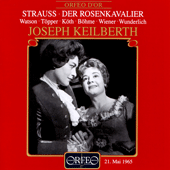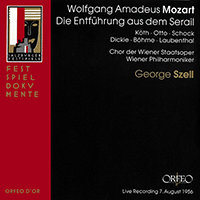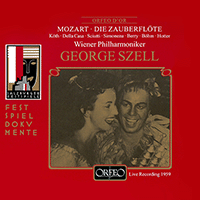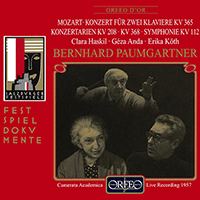Erika Köth
Erika Köth, who as a child had suffered from poliomyelitis, worked during World War II for a coal wholesaler and in a munitions factory. In order to finance her studies (initially with the teachers Mecklenburg and Willner in Darmstadt and then with Elsa Blank in Karslruhe) she occasionally sang with a dance band.
Köth’s breakthrough came in 1947, when she won a singing competition organized by Hesse radio; and during the following year she made her operatic stage debut at Kaiserslautern’s Palatinate Theatre as Philine in Thomas’s Mignon. Between 1950 and 1953 she was a member of the Karlsruhe Opera and in 1953 first appeared with the Munich State Opera, remaining with the company until her retirement in 1978 and singing the Fiakermilli / Arabella and the Italian Soprano / Capriccio during the company’s guest season in 1953 at the Royal Opera House, London.
Also in 1953 Köth sang for the first time with the Vienna State Opera, as the Queen of the Night / Die Zauberflöte, a role in which she made her debut at La Scala, Milan, in 1956. She was a frequent guest at the Salzburg Festival, first appearing there in 1955 as the Queen of the Night and as Konstanze / Die Entführung aus dem Serail. She returned to sing both parts often, the first until 1960 and the second until 1963. In 1958 she took part in the reopening of the Cuvilliés Theatre in Munich, singing Susanna / Le nozze di Figaro, a role with which she was to become closely identified.
Köth first appeared in the USA in 1958 with a concert tour that included the Hollywood Bowl; undertook a successful tour of Russia in 1961; and in 1963 took part in a tour of Japan with the Dresden State Opera, in which she sang four of her most significant roles: Mimì and Musetta / La Bohème, Lucia / Lucia di Lammermoor and Rosina / Il barbiere di Siviglia. During the year of her Russian tour Köth joined the Deutsche Oper, Berlin while continuing to sing as a guest with both the Hamburg and Vienna State Opera Companies; and at the Bayreuth Festival between 1965 and 1968 took the part of the Woodbird / Siegfried.
In 1973 Köth began teaching at the Cologne Conservatory, later moving to Mannheim. Although well known as a coloratura soprano, with a repertoire that included Donna Elvira / Don Giovanni, Violetta / La traviata, Gilda / Rigoletto, Sophie / Der Rosenkavalier, Zerbinetta / Ariadne auf Naxos and Anne Trulove / The Rake’s Progress, Köth also enjoyed a substantial popular following through frequent television appearances and numerous recordings of operetta, to which she was especially well suited. Her farewell performance, in 1978 at the Bavarian State Opera, was as Mimì.
With her rich and flexible high-lying lyric voice and her pert dramatic personality, Köth always delivered performances of the highest professional standard.
© Naxos Rights International Ltd. — David Patmore (A–Z of Singers, Naxos 8.558097-100).























